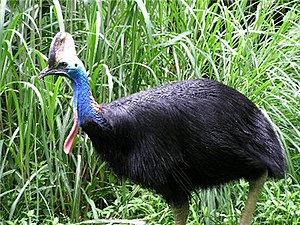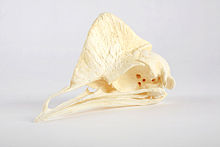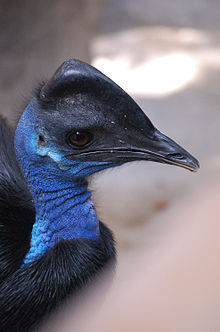Cassowaries
| Cassowaries | ||||||||||||
|---|---|---|---|---|---|---|---|---|---|---|---|---|

Cassowary ( Casuarius casuarius ) |
||||||||||||
| Systematics | ||||||||||||
|
||||||||||||
| Scientific name | ||||||||||||
| Casuarius | ||||||||||||
| Brisson , 1760 | ||||||||||||
| species | ||||||||||||
|
The cassowaries ( Casuarius ) are a genus of large flightless birds from the group of ratites . The distribution area mainly includes the island of New Guinea . They are the largest land animal there. One of the three species also lives on the Australian Cape York Peninsula . The name "cassowary" is derived from the Malay name "kesuari".
The IUCN lists two of the species (single-lobed cassowary and cassowary) as endangered. However, no approximate population figures are known of any of the species, as large parts of the rainforest of New Guinea are still undeveloped. The cassowary is strictly protected in Australia.
features
The cassowaries are distinguished from other ratites by a helmet-like outgrowth on the head covered with horn tissue. The function of this helmet has long been a mystery and the subject of extensive technical discourse. Traditionally, the usefulness of the device has been explained as providing protection against head injuries when moving quickly in dense forest; however, cassowaries always keep their head straight, and the protective function of the helmet only occurs when the head is tilted. A possible main function could be the display of rank; in other words, the size of the helmet reflects the social status of an individual and thus plays a role in social behavior. The helmet could also play a role in the low-frequency acoustic communication of cassowaries. The latest research has now come to the conclusion that the helmet or the internal tissue structure is used to regulate body temperature.
The head is featherless, in two of the three species also the neck. In these two, the blue-red colored skin and drooping skin flaps are visible. The number of these skin lobes characterizes the species: none in the Bennett cassowary , one in the single-lobe cassowary and two in the helmet cassowary . The bright colors could have a signal effect in the dense forest. The color of the skin on the neck can change with the bird's moods.
The monochrome black plumage of the cassowaries has some special features. As with the related emus, the control springs are missing . The flight feathers consist only of the keels. The wings are there, but withered into small stumps.
The legs are extremely strong, have three toes each ( tridactyly ) and allow speeds of up to 50 km / h. The animals have a dagger-like claw up to ten centimeters long on the inner toe of their feet , which can be used as a dangerous weapon.
Adult helmet cassowaries and single-flap cassowaries can be around 1.70 meters high and weigh over 60 kilograms. This makes them one of the largest and heaviest living birds.
The sexes are difficult to distinguish from one another. Females are, on average, slightly larger with brighter colors and larger helmets. However, this is not a sure differentiator. Cassowaries in their youthful dress have brown plumage; they lack the bright colors of the neck areas and the helmet attachments are significantly smaller.
distribution and habitat
Cassowaries live in the tropical rainforests of New Guinea and Queensland . New Guinea is the main distribution area. All three species have similar habitats, but usually avoid meeting because they prefer different altitudes. The single-lobed cassowary lives mainly in lowland forests, the helmet cassowary at medium altitudes and the Bennett cassowary in the mountain rainforest. However, there are overlaps in the habitats and no sharp dividing lines; in areas where the other species do not occur, the Bennett cassowary also descends to sea level. Since they depend on fruit all year round, they can only survive in large forests that are rich in biodiversity.
Australia also seems to have been inhabited by cassowaries in the Pleistocene. Today only the cassowary lives on the Cape York Peninsula in northern Queensland. Here, too, cassowaries are pure forest dwellers; that they are occasionally seen in fields is due to the fact that the increasing destruction of forests makes it necessary to cross such open spaces.
Cassowaries also live on some of the neighboring islands of New Guinea: the cassowary on Seram and the Aru Islands , the Bennett cassowary on New Britain and Yapen and the cassowary on Yapen and Salawati . It is unclear, however, whether these were originally native to the area or whether their occurrence is the result of the New Guinean people's trade in young birds.
Way of life
behavior
The cassowaries are shy birds that live deep in the forest and usually move away before a person notices their presence. Due to the secret way of life, cassowaries have not been adequately researched. They are active at twilight and at night, with activity peaks at dawn and dusk. During the day they rest sitting. They spend most of their time foraging for food. In doing so, they create paths through the undergrowth, which they then use again and again.
Apart from the breeding season, cassowaries are territorial loners. Cassowaries generate low-frequency, booming sounds down to 23 Hertz , which may be used for communication. Low-frequency sounds are not attenuated even over long distances, so they would be a suitable means of communication in the dense rainforest. The helmet is perhaps suitable for picking up such deep sounds. At the moment, however, the function of the helmet and the intra-species communication of the cassowaries have not been adequately researched for definitive conclusions.
Cassowaries, in particular, can be extremely aggressive when they have cubs or feel cornered. An attack is usually preceded by threatening gestures in which the feathers are straightened, the head is tilted to the ground, the neck swells and the body begins to tremble. If there is actually an attack, the cassowary kicks with both legs at the same time. The dagger-like claw can cause very serious injuries - deaths have also occurred, but are rare.
Reproduction
The exact breeding time of the individual species is not known. Most populations appear to breed between June and October, but breeding birds have been found at any time of the year. The males watch over a territory with an area of one to five square kilometers. If this enters a female, the male begins courtship . The plumage is set up and the female slowly circled; the neck is inflated, glows particularly brightly, and a dull "buu-buu-buu" is uttered.
After copulation , the couple stays together for a few weeks. The female lays three to five eggs in a nest pit prepared by the male. They are quite large eggs that can weigh up to 650 grams. After laying, the female leaves the nest. Often it now goes to the territory of another male to mate with this one. The male remains alone with the clutch and takes care of the brood and rearing alone.
The young hatch after 49 to 56 days of incubation . They wear a light brown plumage with darker stripes running lengthways along the body. The young can run around a few hours after hatching and follow the father for about nine months. Before they are half a year old, they change into the plain brown youth dress; about the same time the helmet begins to become visible. During their second year of life, cassowaries gradually take on the appearance of the adult birds and reach their size. Cassowaries are sexually mature at the age of three and a half.
Little is known about the potential lifespan. Estimates assume a range between twelve and 19 years in the wild. In the zoo, cassowaries reached the age of 40 years.
nutrition
Cassowaries feed mainly on fruits that they pick up from the ground or pick from the lower branches. They also eat mushrooms , insects , frogs , snakes and other small animals. Like other ratites, cassowaries swallow stones, which serve as gastroliths in the stomach to break up food. You drink regularly; Water is mostly available in abundance in their habitats.
Enemies
Besides humans, cassowaries have no natural enemies in New Guinea, at most feral dogs can be dangerous to young birds.
Systematics

Within the primitive jaw birds , the closest relatives of the cassowaries are the emus , with which they are united in a common family and a common order Casuariiformes . The cassowaries themselves comprise three species, all of which are assigned to a single genus Casuarius .
- Bennett cassowary or moruk , Casuarius bennetti
- Cassowary or southern cassowary , Casuarius casuarius
- Northern cassowary also Rothalskasuar , Casuarius unappendiculatus
The existence of a fourth species ( Papuan cassowary Casuarius papuanus ) can be disputed, as the differences to the Bennett cassowary are small. A total of 42 subspecies of these three species have been described. Often such descriptions were made on the basis of captured birds whose origin was unknown. Since the differences between sexes, age groups and individuals have not been adequately researched, a division of the cassowary species into subspecies does not currently make sense.
Fossil history
Cassowaries fossil finds are rare. Most of the finds are only fragments that cannot be safely assigned to emus or cassowaries. All of these finds come from Australia. A find that could definitely be assigned to a Bennett cassowary comes from the Pleistocene of New South Wales and suggests that cassowaries in Australia may once have had a much wider distribution than they are today. Only one fossil find is older than the Pleistocene; it dates from the Pliocene of Australia four million years ago, and its assignment to the cassowaries is uncertain.
Cassowaries and people
Importance in the lives of the Papuan peoples
Cassowaries have played a role in the everyday life of the Papuan peoples for centuries. On the one hand, they are hunted for their meat, which is considered very tasty. The feathers serve as decoration, and even the bare quills of the wing feathers can still be used as nose and lip sticks. The claws were used as arrowheads , and the leg bones were used to make tools and weapons. None of the ethnic groups living in New Guinea have successfully domesticated these birds, but young birds are repeatedly captured and reared in order to eat them later.
Cassowaries were considered so valuable that there had been trade between the Papuans and seafaring peoples of Southeast Asia for at least five hundred years. The Papuans brought mostly young cassowaries to the coasts and exchanged them for goods; The equivalent of eight pigs for a cassowary is said to have been common. It is assumed that the wild cassowaries of some small islands reached their current distribution areas in this way.
In addition to being of practical use, cassowaries also played a spiritual role in the Papuan communities. They appear in numerous myths and fables. Since there are so many different Papuan peoples with very different customs and traditions, nothing general can be said about these beliefs. Two examples should be mentioned: The Kalam people consider cassowaries to be reincarnations of their female ancestors, which is why hunting cassowaries is prohibited among them. With the Ilahita Arapesh , the tribal goddess appears in the form of a cassowary and is part of many fertility rites.
Deaths
The strong legs and long claws are dangerous weapons that cassowaries can also use against humans. There are repeated reports of encounters between cassowaries and people in New Guinea that are fatal for humans. However, none of these incidents are documented and they are believed to be extremely rare.
Only two incidents are considered certain. The first occurred in Australia when 16-year-old Phillip McClean from Queensland was killed by a cassowary in 1926. After the boy discovered the bird on the family's property, he and his brother wanted to kill the animal with clubs. The cassowary knocked him to the ground and kicked him, ripping open McClean's carotid artery with his claws. Although the boy was still able to run away, he collapsed shortly afterwards and died from the loss of blood. A second death occurred in Florida on April 12, 2019. The 75-year-old owner of the bird fell while feeding his animal, was attacked by it and later succumbed to his injuries in the hospital.
attitude
The first cassowary was introduced to Europe in 1597. Since then, all three species have been shown in European zoos. The most frequently shown is the cassowary, which was first bred in human care at London Zoo in 1862 and 1863. Breeding in zoo keeping is comparatively rare, however, since cassowaries live solitary and, due to their aggressive behavior, can hardly be kept together with other species. For breeding, attempts are usually made to get the pairs used to each other in neighboring enclosures. If you get used to it, cassowaries get along well, at least during the breeding season.
literature
- Mark Cocker, David Tipling: Birds and People . Jonathan Cape, London 2013, ISBN 978-0-2240-8174-0 .
- Josep del Hoyo (et al.): Handbook of the Birds of the World. Volume 1: Ostrich to Ducks. Lynx Edicions, Barcelona 1992, ISBN 84-87334-10-5 .
Movie
- Cassowaries - Australia's weird birds. Documentation, Australia, 2008, 43 min., Script and director: Bianca Keeley, production: ZDF , German first broadcast: January 13, 2009, summary by arte
Individual evidence
- ^ A b c A. L. Mack & J. Jones (2003): Low-Frequency Vocalizations by Cassowaries (Casuarius spp.) . The Auk 120 (4): 1062-1068.
- ↑ Lars Fischer: Why is this bird wearing a helmet? , Spektrum.de , April 3, 2019.
- ↑ Christopher M. Perrins (ed.): The BLV encyclopedia birds of the world. Translated from the English by Einhard Bezzel. BLV, Munich / Vienna / Zurich 2004, ISBN 978-3-405-16682-3 , p. 45 (title of the original English edition: The New Encyclopedia Of Birds. Oxford University Press, Oxford 2003).
- ^ IOC World Bird List: Ratites: tinamous to kiwis
- ↑ Mark Cocker, David Tipling: Birds and People . Jonathan Cape, London 2013, ISBN 978-0-2240-8174-0 . P. 21
- ↑ Mark Cocker, David Tipling: Birds and People . Jonathan Cape, London 2013, ISBN 978-0-2240-8174-0 . P. 22
- ↑ Kofron, Christopher P., Chapman, Angela: Causes of mortality to the endangered Southern Cassowary Casuarius casuariusjohnsonii in Queensland, Australia , In: Pacific Conservation Biology, Volume 12, pp. 175-179, 2006
- ↑ Liana Christensen: Deadly Beautiful: Vanishing Killers of the Animal Kingdom . Exisle Publishing, Wollombi, 2011, p. 272, ISBN 9781921497223
- ^ Authorities: Large, flightless bird kills its Florida owner. ABCNews / The Associated Press , April 14, 2019, accessed April 14, 2019 .
- ↑ a b W. Grummt, H. Strehlow (Ed.): Zoo animal keeping birds . Verlag Harri Deutsch, Frankfurt am Main 2009, ISBN 978-3-8171-1636-2 . P. 48



